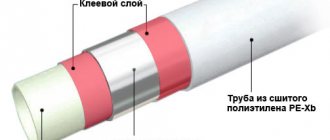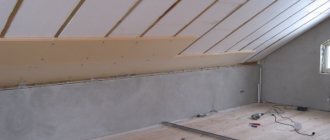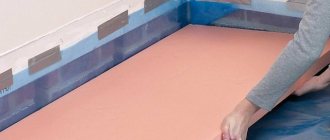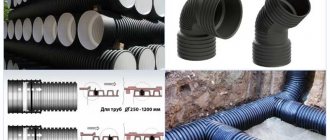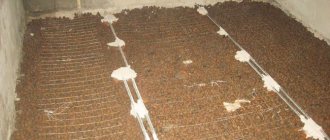Water is supplied to an individual house from any water supply source through an underground pipeline, the probability of freezing in winter is quite high. It is not always effective and technically possible to immerse a water pipeline to a great depth underground; many owners of land plots with an autonomous water supply have to solve the problem of how to insulate a water pipe in the ground.
To supply water to the house, no one uses underground metal pipes, which are prohibited for laying underground without waterproofing by building regulations; the leader in household use is a pipeline made of low-density polyethylene (HDPE) with a diameter of 1 to 2 inches. Although polyethylene has a low thermal conductivity, unlike steel, and is more resistant to freezing due to its elasticity, when laid at shallow depths it should be insulated using one of the many methods used in the construction industry.
Soil freezing depth in the Moscow region (in centimeters)
Main types of pipe insulation
I would like to immediately note that the most effective will be timely insulation, which is best done immediately at the time of laying the pipeline. Many people consider it sufficient to bury pipes to a decent depth.
- However, as we have already said, this is not always possible due to the characteristics of the soil .
- Secondly, if you plan to carry out the work yourself , then you will inevitably face a very long and labor-intensive process . It is advisable to dig deep trenches if you have special equipment at your disposal to make this task easier.
- And thirdly, if you are faced with the need to perform local repairs or replace a damaged pipe segment, this will be problematic due to the great depth .
Doing without insulation , especially now, when the range of thermal insulation materials is so wide, and simply relying on the fact that the climate will be favorable to you, is a rather reckless decision .
After all, it’s hard not to notice that lately the weather has been giving us surprises in the form of abnormal frosts or, conversely, abnormal heat. Depending on the type of materials used, insulation methods can be divided into three types:
- Reflective - when materials with an additional foil or aluminum layer , which reflect the cold from the environment and do not allow it to affect the surface of the pipe;
- Preventing heat loss - we are talking about materials that have a low coefficient of thermal conductivity , water and vapor permeability;
- Heating – when more modern methods are used, for example, a heating cable.
In this case, insulation occurs due to the heat generated by the heater. In order to minimize heat loss and direct it as much as possible to the heated pipe, it is additionally recommended to insulate with materials with a foil layer.
Requirements for thermal insulation materials
Whatever type of insulation you choose, you will still have to face the challenge of choosing the right material. First you need to decide what qualities material should have that can really provide the desired result.
- The most important parameter is the value of its thermal conductivity coefficient . The lower this value, the better the thermal insulation will ultimately be;
- If we are talking about insulating the most vulnerable sections of the pipeline, namely those that run in open ground , it is necessary to select materials with high density and resistance to deformation . The soil layer exerts significant pressure on the surface of the pipe, and therefore the insulation. Moreover, the pressure value may vary depending on the amount and frequency of precipitation, average temperature and other indicators;
- An important condition is increased moisture resistance . Under the influence of moisture, which may be in excess in the surrounding soil, many insulation materials lose their insulating properties;
- Also, moisture in the soil can have a detrimental effect on the surface of the pipes, which over time will manifest itself as corrosion. Thermal insulation material, in addition to protection against freezing, additionally acts as a defense and from this undesirable phenomenon. Therefore its structure should be corrosion resistant;
- For plastic plumbing, fire safety is very important , which means the insulation must be fire-resistant ;
- The material must withstand high temperatures and not undergo deformation during sudden temperature changes;
- For economic benefit, it is better to choose insulation that can be reused ;
- The determining factor is the durability of the material . It will not always be economically profitable to purchase cheaper material in the future. It is better to spend a little more money and ensure reliable insulation that will last for several decades than to regularly replace the insulation simply because it has lost its properties. Not to mention that this would require digging up trenches and then re-burying them.
Mineral wool for pipe insulation
Thermal insulation using varieties of mineral wool has become widespread due to its affordable cost. With its help you can insulate heating pipes, hot water supply, water supply and sewer systems, as well as air ducts. This material works on the principle of a thermos. In addition, cotton wool protects the surface of the pipes from condensation . In the case of insulation of an underground pipeline, it is imperative to provide additional protection from moisture, so when wet, cotton wool loses its protective properties , and heat loss, in turn, increases. Mineral wool is a fibrous material for the production of which various raw materials are used. The most commonly used types are:
- Glass wool – made from the same raw materials that are used to make glass. Its fibers are quite thick. For convenience, glass wool is available in the form of slabs, rolls or shells. To protect against moisture, one side can be covered with foil or a thin layer of aluminum. The thermal conductivity coefficient is 0.030-0.052 W/m*K. The material belongs to the NG class - non-flammable. When installing glass wool, you must be extremely careful and take care of personal protective equipment. Because with any touch to the material, small sharp particles fly in different directions, which dig into the skin even through fabric gloves. It is especially important to protect the organs of vision and breathing, since particles entering the lungs cause severe and prolonged swelling;
- Basalt cotton wool - made from molten rocks. It weighs more than glass wool. The material is also non-flammable and able to withstand exposure to very high temperatures – up to 870°С. Index thermal conductivity more shortthan the previous variety and is 0.035-0.039 W/m*K. Differs more high density and hardness. In this regard, the release form can be either in the form of plates or in the form of cylinders. Additional foil layer can be implemented on both forms;
- Slag wool – made from waste from iron production. For pipe insulation use enough rarely.
This is explained by the increased friability and acidity of the material, on the surface of which oxides form over time, negatively affecting the surface of the pipes . In addition, the material cannot be classified as environmentally friendly. And its thermal conductivity is quite high for a thermal insulation material - 0.46-0.48 W/m*K .
Foam plastic for pipe insulation
This material is a fairly effective insulation material that is lightweight . This greatly simplifies the installation process. Due to sufficient rigidity and strength, the foam does not deform under soil pressure. The main form of production of polystyrene foam pipe insulation is cylinders. They consist of two halves, which are connected to each other by means of a tongue and groove.
This is not only very
convenient , but also completely eliminates the possibility of the formation of cold bridges . The most common types of foam are:
- Penoizol;
- Extruded polystyrene foam;
- Expanded polystyrene foam.
The above materials differ in their density . Depending on this, the thickness of the thermal insulation layer also changes, which can range from 20 to 100 mm or more .
The internal diameters of the foam cylinders are equal to the standard external diameters of water pipes , which allows them to be insulated, provided that they fall within the diameter range from 15 to 144 mm .
operating temperature range of the material is also sufficient - from -188 to +95°C . Foam shells are often used for noise and heat insulation not only of plumbing, but also of ventilation and air conditioning systems, sewerage and gas pipelines. By choosing one of the types of polystyrene foam as insulation, you can count on the following advantages:
- Minimal heat loss;
- Protection of pipes from corrosion ;
- Tightness of the heat-insulating layer;
- Possibility of reusable use;
- Opportunity use as additional insulation during insulation heating cable. Since there are varieties of cylinders with special groove for cable routing;
- Resistance to the chemical effects of salts, lime and acids that may be present in the soil, as well as to the vital processes of various microorganisms;
- Durability;
- Resistance to sudden temperature changes ;
- Possibility to choose a protective shell even for fittings connections due to the presence of shaped parts.
Among the disadvantages , one can note increased sensitivity to solvents such as gasoline, acetone, and nitro paint. Under their influence, the material simply melts.
A little about plumbing
In private construction, an open water supply system is often used to supply water from a well. It is simpler, faster and easier to assemble, and does not require the use of special equipment, for example, an excavator, etc. There is one big drawback to such a system: it is extremely sensitive to temperature changes, so it requires reliable insulation to maintain functionality. In some cases, especially when violations were made during insulation, freezing still occurs, which can lead to a pipeline rupture.
You can minimize the risk of rupture during freezing; to do this, you need to choose the material from which the pipe is made. Metal and metal-plastic pipes are most susceptible to rupture; their use is not recommended. Plastic pipe options are capable of expanding slightly under ice pressure, so their rupture when freezing occurs extremely rarely.
Water supply made of plastic pipes
Foamed polyethylene
Many experts note that among the variety of thermal insulation materials, it is polyethylene varieties that are the most optimal in terms of price/quality ratio. The structure of polyethylene consists of many closed cells, inside of which there is air, which, as is known, has the lowest thermal conductivity coefficient - only 0.024 W/m*K. There are:
- cross-linked (FPPE or HPPE) polyethylene foam, which is obtained by foaming the molten composition;
- non-crosslinked (NPE) polyethylene foam, for the production of which an extruder is used.
The structure of NPE is long linear molecules, between which there is no chemical bond. While cross-linked polyethylene has a denser consisting of smaller cells , with a stable molecular bond. You can even distinguish these two varieties visually.
Depending on the production method, the technical characteristics differ .
- Cross-linked polyethylene will have a lower thermal conductivity and higher density , making it resistant to deformation. But its cost higher than unstitched. Density ranges from 25 to 40 kg/m3 ;
- The material has increased elasticity , which is maintained even at low temperatures (-80°C) . This makes installation much easier;
- With a force of 5000 N/m2. the compression ratio of polyethylene is only 0.2;
- Due to the minimum value of the vapor permeability , which is 0.001 mg/m*h*Pa, the material can be classified as completely vapor-proof ;
- Coefficient of thermal conductivity amounts to 0.035 W/m*K;
- Polyethylene also has a low water absorption rate . When the material is immersed in water for a day, it absorbs no more than 0.5% of moisture from its volume. Moreover, upon reaching the figure of 1.9% after more time, water absorption stops increasing;
- The flammability class of the material is G2 ( moderately flammable );
- Moreover, in the event of inflammation, the material does not release substances to the body ;
- The structure of the material is not susceptible to the effects of various chemical elements .
- Polyethylene may have release form in the form of hollow cylinders with a technical slot along the entire length, sheets and rolls.
The material may have an additional protective layer of foil .
How to insulate a well and water supply system for the winter with your own hands ↑
Working with modern materials is very easy
Place a special insulating material on the pipes: Merylon, shell (foam plastic), basalt fiber. They have the shape of a pipe and vary in diameter.
The installation method in this case consists of threading the pipes into the insulation tubes. Fasten the heating cable to the pipe. It independently regulates the temperature and heats up if necessary, which will prevent the water in the pipe from freezing. It will need to be strengthened to the surface and covered with a layer of insulation or waterproofing. Use a ready-made insulated pipe.
It consists of two pipes that differ in diameter, and insulation is laid in the internal distance between them, usually having a fibrous structure: fiberglass, basalt. The space can also be filled with polyurethane foam. Sometimes a heating cable is attached to the inner pipe.
Polystyrene foam can completely block the access of cold to the pipe
Make an insulated pipe with your own hands.
To do this, thread a water pipe into a large pipe. Push insulation (glass wool, basalt) tightly into the space between them. The disadvantage of this option is the possibility of voids forming or uneven laying of the insulation.
This, of course, is not a complete list of options for how to insulate a pipe; we have presented only the most common ones. Each owner can come up with others or get creative and combine the above.
It is worth noting another well-known method, which has become quite widespread due to its availability - sheets of foam plastic are laid over the water pipe running from the well to the house, because foam has high thermal insulation properties. The sheets are simply laid over the trench and covered with soil.
Polyurethane foam (PPU)
This material is no less effective insulation. To insulate the pipes, a polyurethane foam shell is used , which is a cylinder. It is made in two ways:
- By pouring liquid polyurethane under high pressure into a special mold:
- Manufactured using the “pipe in pipe” method . In this case, the material is poured into the cavity between two pipes - the inner one, with a smaller diameter, and the outer one, with a larger diameter.
The first option is suitable for yourself . And the product of the second production method is pre-insulated pipes ready for laying a new pipeline .
- This is a completely new product that makes it possible not to think about additional insulation ;
- In this case, the outer layer can be corrugated - flexible, which makes it possible to avoid the need to use rotary fittings , that is, the pipeline can be laid with a minimum number of connections;
- Both one- and two-pipe versions of such ready-made elements are produced;
- For laying cold pipeline designs are better suited with plastic pipes;
- For hot dishes, they produce more expensive options with metal pipes inside;
- Flexible pipes with pre-insulation are supplied in coils and have a length of up to 200 meters .
Regarding PU shell , it has the following advantages:
- Heat loss is reduced by almost 40% ;
- Installation of the elements is so simple that it allows you to independently insulate several hundred meters of pipeline in a day;
- This also indicates the speed of installation;
- The material is environmentally friendly ;
- The insulation can be reused an unlimited number of times;
- Term operation reaches 30 years.
Among the disadvantages is the impossibility of using the material at temperatures above 120°C . A great convenience is the presence of shaped segments, such as tees, elbows and branches. The connection of two shell fragments to each other occurs using a special coupling , which makes the thermal insulation airtight and prevents the possibility of the formation of cold bridges.
The shell also
differs in the material of its outer covering, which determines its scope of application. The coating can protect both from environmental factors, such as ultraviolet radiation, and from mechanical influences.
- Uncoated polyurethane foam is the most affordable, but can only be used for insulating pipes located, for example, in the basement, and then only if there is an additional casing . Either as an intermediate insulating layer;
- Shell with foil coating - the scope of application is not limited, and the material is characterized by increased strength ;
- Shells coated with fiberglass can be used to insulate external sections of the pipeline, for example, places where pipes enter the house. It is distinguished by its resistance to ultraviolet radiation . At the same time, fiberglass is also distinguished by high hardness , which virtually eliminates the possibility of mechanical damage ;
- The glassine coating is resistant to direct sunlight, but is inferior to fiberglass in strength;
- Shell coated with reinforced aluminum foil (armofol) - used for insulation of pipelines operated under conditions of significant temperature changes ;
- Galvanized steel coating is used to insulate pipelines running in air . Steel protects the shell from ultraviolet radiation, mechanical and biological influences, but at the same time is more affordable than a fiberglass coating.
The thickness of the shell is 20-80 mm and increases with increasing diameter. The length of one element does not exceed 1 meter , taking into account the peculiarities of the manufacturing process.
Installation of shells made of basalt or expanded polystyrene
Insulation for water pipes made of basalt or expanded polystyrene is installed using the following technology:
Advice! It is best to start installation from the flange connection.
- shell halves of the corresponding internal diameter are placed on the pipe, with an overlap of 10-20 cm relative to each other required;
- preliminary fastening can be done with tape;
- in places of pipe outlets, specially selected segments or segments cut from straight sections of the shell are used;
- for thermal insulation of street areas, roofing felt or foil insulation can be used as a protective material;
- final fastening to the pipe is carried out using the tightening method;
- If dismantling is necessary, it is carried out in the reverse order.
Foamed rubber for pipeline insulation
This material is made from natural or synthetic rubber and is classified as a material with increased elasticity. At the same time, high tear resistance . The structure of rubber is 90% closed cells. This allowed us to achieve the following positive characteristics:
- The thermal conductivity coefficient is 0.024-0.038 W/m*K and directly depends on the ambient temperature. The highest indicator is observed at 0…+20°С ;
- The material has excellent anti-corrosion properties;
- Shows resistance to substances such as gasoline and oil ;
- Has a low coefficient of water absorption and vapor permeability;
- operating temperature range is quite wide - from -200 to +150°C ;
- Under conditions of sudden temperature changes, it retains its properties unchanged ;
- In addition to reliable thermal insulation, it also provides high noise insulation ;
- Can be reused ;
- Is durable ;
The form of release of foamed rubber is sheets or hollow cylinders with a technical slot equipped with an adhesive layer. thickness is 6-32 mm , and the internal diameter is designed for pipes with a diameter of 6 to 114 mm .
General information
And under no circumstances should the water inside the structure be allowed to freeze, otherwise it can rupture and damage the entire plumbing system.
There are two weak points in a home plumbing system.
- The location of the pipeline on the street under a layer of earth.
- The pipeline is located in an unheated room.
If it is easier to insulate the water supply in a private house that is located indoors, then the water supply that is laid outside requires a more thoughtful approach. Basically, it all depends on the quality of the insulation used.
A good insulation for water supply should have the following characteristics:
- low thermal conductivity;
- durability;
- ease of installation;
- resistance to aggressive environments;
- must withstand the operating temperature of the environment;
- fire safety and tightness;
- low price with the possibility of repeated use
Based on these characteristics, the optimal thermal insulation for water supply in a private house is selected. Today there are a large number of insulation materials. Below we will analyze some of them.
Heating electric cable
One of the most effective ways to ensure long-term protection of pipes from freezing is the use of a heating cable. The advantage of this solution is that installation can be done both on top of the pipe and inside it. It all depends on the condition of the pipeline and the diameter of the pipes. When choosing an internal installation method, keep in mind that the cable may reduce the permeability of the pipes if their diameter is too small. The recommended minimum pipe internal diameter size is 40 mm. The heating cable itself can be of two types:
- Resistive;
- Self-regulating.
The latter type is more advanced, convenient and cost-effective. Its cost exceeds the cost of a resistive cable.
However, given that the finished heating system can operate almost completely without human intervention and requires minimal attention, it can be argued that the expense is justified.
A more complete description of both types of heating cable and the features of its selection and installation can be found in our article by following this link.
Liquid thermal insulation for pipelines
A completely new method of insulation is the use of special coloring compounds. Even a thin layer of such paint can replace 10-20 mm thick insulation . And if you apply the composition in several layers, you can achieve much better results. Heat loss can be reduced by up to 40% , while the coating does not allow water and moisture to pass through, but remains “breathable”. Liquid insulation is classified as energy-saving thermal paint and can be of two types:
- Ceramic , its consistency really resembles ordinary paint;
- As foam structure, which is applied to the desired surface by spraying.
The coating works on the principle of a thermos . The layer of material required for thermal insulation is very thin - only 0.5 mm . The advantages of this method of insulation include:
- When using the composition in the form of paint, its application simple and can be done with a regular brush ;
- If the coating chips or scratches form on it, it can be easily restored ;
- Low thermal conductivity;
- High elasticity , which allows the coating not to crack when the pipe diameter expands and contracts;
- Long service life;
- Health safety
- Condensation and corrosion do not form on the surface ;
- Possibility of application to surfaces of any configuration.
The disadvantages include:
- High cost of the composition;
- a foam composition as insulation , you will need to seek help from specialists . Which, as you know, provide their services only for large volumes of work. If you want to spray just a few meters of pipeline, you may simply not find a contractor.
Underground
- You can properly insulate an underground water pipe by digging a deep trench and properly laying the insulation.
The pipe is wrapped in basalt and secured with tape. A protective layer must be placed on top. Roofing felt (or any durable waterproofing material) is ideal for this.
The foam parts are connected to the pipe using special joints cut along the edges. Additional fixation is provided by adhesive tape glued with waterproof glue. A protective layer is also applied on top.
- A heating cable is considered the most reliable heating method. Although it is the most expensive, it is suitable even at a depth of 2 meters for seasonal living. It does not require deep trenches (if you live permanently), 50 cm is enough.
Pipes are insulated
The cable must be wrapped around the pipe every 10 cm. After 15 cm, it is fixed with adhesive tape. The top must be covered with insulating material. Some craftsmen suggest placing it inside the pipe, but this is somewhat more difficult to do.
Additionally, temperature sensors are installed. There are 3-4 sensors located along the entire length. Their installation will provide the opportunity to set up automatic heating or manual control.
Such a heating system will provide a continuous flow of water into the house even on the coldest days, and will never fail. The cable sells for an average of 500 rubles per meter. Consumes only 10, maximum 20 W. These costs are justified if the water supply in your area is not too long.
- Being under strong pressure, water cannot freeze. Therefore, this method has gained popularity among craftsmen. Installation is carried out from the receiver, we connect the valve to the pump. We check the system: close the tap and start the pump.
In apartments, of course, this method is not used. Only in areas with a well or borehole. And only in case of seasonal residence of the owners of the house. In winter there should be no one in it. Although this method allows you to save on insulation of the water supply system, it is not always appropriate.
- Air insulation, mentioned above, requires the creation of special conditions for the water supply. With this method, water pipes are placed in other plastic pipes (for communications) of larger diameter, thus creating a kind of air cushion. Cold air does not reach the water flow from above, and from below the system absorbs the heat of the earth. For this method of insulation, which involves insulating material and additional pipes, it is necessary to dig a trench of at least 1 meter.
However, having chosen this method, you should remember that such a water flow will be difficult to reconstruct if necessary. The method is certainly interesting, effective, and inexpensive. But you may have to pay twice.
High pressure thermal insulation
As a method of insulating a pipeline in a private house or country house, one can consider creating and maintaining high pressure in it. How it's done:
- to embed a receiver into the finished pipeline , which will have to create the necessary pressure - 3-5 atmospheres is quite enough;
- It is also necessary to additionally use submersible pump, to create pressure from 5 to 7 atm.;
- After the pump, a check valve and a tap are installed in front of the receiver;
- To start the system, you need to close the tap in front of the receiver and turn on the pump;
- The resulting pressure must be maintained in the system continuously until it is in use;
- To allow the pipeline to function again, you simply need to bleed off the excess air.
Air insulation
Understanding the characteristics of soil freezing in winter, you can use the thermal insulation method, when warm air from the bowels of the earth is used to heat the pipe. As you know, the soil freezes from top to bottom, while heat continues to flow from below. When insulating shells are used, this heat is simply cut off and not used.
To
save on the amount of insulation materials, you can create a structure that will resemble an umbrella . And work on the same principle. The cold from above will be insulated , and the heat coming from below will be concentrated at the depth of the pipeline.
This can be done using a flexible material with low thermal conductivity, which is laid in an arc over the pipe in a trench and then simply covered with soil. Additionally, you can fill the free space around the pipe with expanded clay. The article was written for the site.
Tags:Pipes
Protection of wells and wells in winter
In winter, water comes into the water supply system at the dacha from a well, a well or the main water supply system, if one is available. Most often, the source of water in dachas, and even in the private sector, is an ordinary well of not very deep depth. The advantage of such a source is that a high-power pump is not required to supply water.
In addition to the pump for such a water supply system, it is advisable to use a hydraulic accumulator, which is a large-capacity barrel. It accumulates a certain supply of water, which can be used at any time. This is especially true during a power outage.
In addition, the hydraulic accumulator helps protect the water supply from water hammer and pressure surges. It and the pump are best installed in a warm utility room where they can be easily maintained.
In addition to pipes, water sources need protection from frost: wells and wells. In order to prevent the water in the well from freezing, a caisson well or pit with a depth of one and a half to two meters is installed, where a person can safely go down the stairs to carry out maintenance on the pump or the well itself.
Caisson well or pit
The walls of the pit can be made of brick, plastic, cast from concrete and made of concrete rings.
They must be sheathed with foam boards, the thickness of which reaches more than 10 cm, or lined with mineral wool. The top of the well must be covered with a powerful lid, well insulated with glass wool or other material. Waterproofing is also carried out to prevent water from entering the coffered well.
Water in wells lined with wooden beams rarely freezes in winter. To protect such wells, a thick protective wooden cover is installed during the winter.
But concrete wells require quite powerful insulation, especially if the water is above the freezing level of the soil. To do this, the well ring is dug out to the freezing level, and then insulated with polystyrene foam compressed in the form of half rings.
Before starting work, the seams in the concrete are treated with a special sealant, then foam plastic is installed. To protect the insulation from sunlight, it is covered with plaster or paint.
It will be useful to read:
